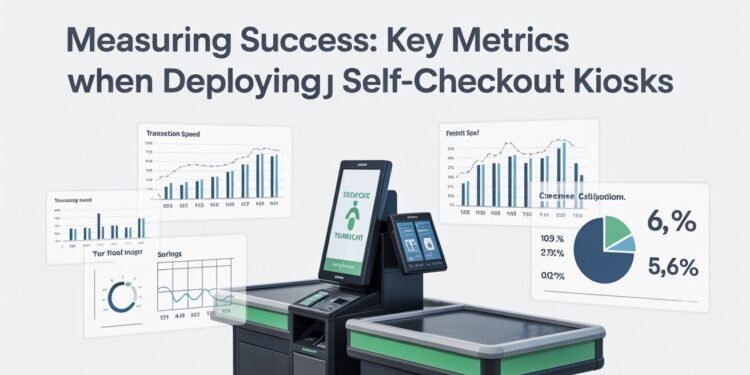Last Updated on November 11, 2025 by admin
The retail landscape is rapidly shifting as more businesses prioritize efficiency and convenience for their shoppers. Self-checkout kiosks have become a hallmark of this trend, enabling customers to control their own transactions and often resulting in shorter lines and quicker visits. To maximize their benefits, however, retailers must closely monitor the efficacy of these kiosks. Understanding which metrics truly indicate a successful deployment is essential for shaping a seamless customer experience and driving operational improvements. As businesses implement self checkout kiosks, evaluating their actual impact becomes paramount.
Identifying clear success metrics not only justifies the investment but also provides valuable insights for continuous enhancement. The right data points reveal not only how well kiosks are performing, but also where adjustments are necessary to meet customer expectations and business objectives. In today’s retail environment, strategic monitoring of self-checkout systems is crucial to maintaining competitiveness and optimizing store operations.
As with any retail technology rollout, success is measured by more than just initial customer adoption. The ongoing impact on checkout efficiency, user satisfaction, labor costs, and overall sales performance determines whether an organization is reaping the full advantages of these innovative solutions. Retailers who invest in robust, data-driven evaluations will stay ahead of shifting trends and evolving consumer demands.
According to industry research, the most successful self-checkout deployments prioritize real-time analytics, customer feedback, and flexibility in adapting to changing operational needs.
Transaction Time
One of the key benefits of self-checkout is its potential to reduce the time customers spend at the register. Transaction time measures the average length of each checkout process, from scanning the first item to completing payment. A reduction in transaction time indicates improved efficiency and increased customer throughput, which are crucial during busy periods and high-traffic locations. Major chains, such as Target, have demonstrated tangible improvements—Target reported that express self-checkout lanes, limited to ten items or less, led to an 8% decrease in average transaction time for both self-checkout and staffed registers since early 2024 (Retail Dive).
Utilization Rate
Adoption and usage rates are key barometers for the success of self-checkout kiosks. The utilization rate refers to the proportion of shoppers who select self-checkout over traditional cashier stations. High utilization suggests that customers find the kiosks accessible, intuitive, and reliable. According to a 2023 survey, 73% of consumers favor self-checkout options, underscoring strong public acceptance (KIOSK). Monitoring this figure allows retailers to identify missing features or friction points that may hinder broader adoption.
Order Accuracy
For self-checkout kiosks to build lasting trust, they must consistently provide accurate order processing and fulfillment. This means ensuring that items are scanned and priced correctly, and that the checkout process prevents both accidental and intentional errors. Tracking error rates, such as mismatches between items and receipts or failure to apply discounts, helps identify where improvements in software, hardware, or training may be required. Elevated order accuracy preserves integrity and cultivates customer loyalty by minimizing frustrating post-purchase issues.
Customer Satisfaction
Customer satisfaction is a central metric in any new retail technology deployment. Gathering actionable feedback through post-transaction surveys, direct input, and social media sentiment analysis provides both qualitative and quantitative insights into the strengths and weaknesses of the self-checkout experience. With 83% of shoppers reporting that money-saving technology strategies, such as efficient checkout, are important factors when choosing a grocer, prioritizing satisfaction is essential (Supermarket Perimeter). Recurring complaints or suggestions can pinpoint software usability issues, unclear instructions, or insufficient staff assistance.
Labor Cost Savings
A significant business case for self-checkout kiosks is their ability to reduce the need for front-end staff. By automating routine teller functions, retailers can reassign team members to customer service roles or reduce overall labor expenses. Tracking shifts in labor spending after the introduction of self-checkout stations offers concrete evidence of savings and identifies whether subsequent hires or reassignments are offsetting projected reductions. Some businesses have reported labor savings of 10-15% after adopting self-service options (Gitnux).
System Uptime
Uptime is an often overlooked but essential metric—the best kiosk solution is only effective if it’s available when customers need it. Frequent technical glitches, hardware malfunctions, or connectivity issues can create bottlenecks and negatively impact the overall perception of the checkout system. Regular tracking of system uptime ensures that self-checkout kiosks provide reliable and consistent service, especially during peak hours. Retailers need to invest in preventive maintenance and support to minimize downtime.
Sales Performance
Analyzing sales metrics specifically for self-checkout transactions helps uncover trends in average order values, product mix, and promotional effectiveness. Self-checkout AOV is a valuable indicator; increases may signal successful in-store messaging, upselling efforts, or growing customer confidence in using the system for larger purchases. Patterns revealed in sales performance data can help retailers make more informed decisions about merchandising and operations.
Final Thoughts
Self-checkout kiosks are transforming modern retail by blending efficiency, convenience, and cost savings. To ensure these systems deliver lasting value, retailers must go beyond initial deployment and engage in ongoing, data-driven analysis of crucial performance indicators. By focusing on transaction speed, utilization rates, accuracy, customer satisfaction, labor cost savings, system uptime, and sales outcomes, businesses can continuously refine their self-checkout offering and maintain a competitive edge in the rapidly evolving retail sector. For further reading on optimizing retail technology investments, reputable publications such as Forbes offer in-depth industry perspectives.
Do Read: How RepMove Changes the Game for the Software Sales Rep










